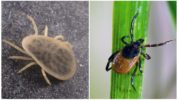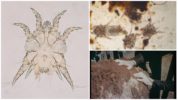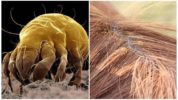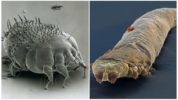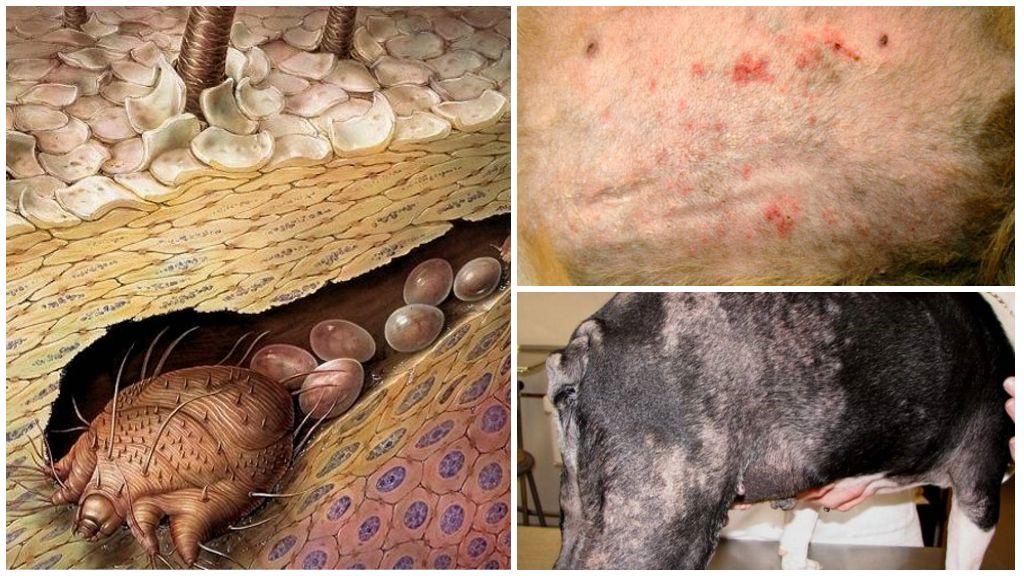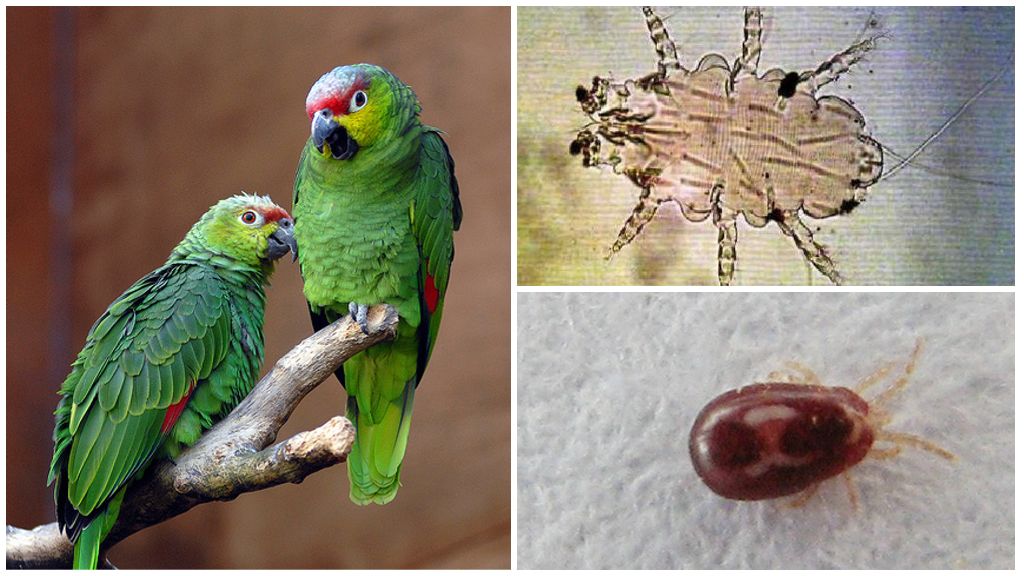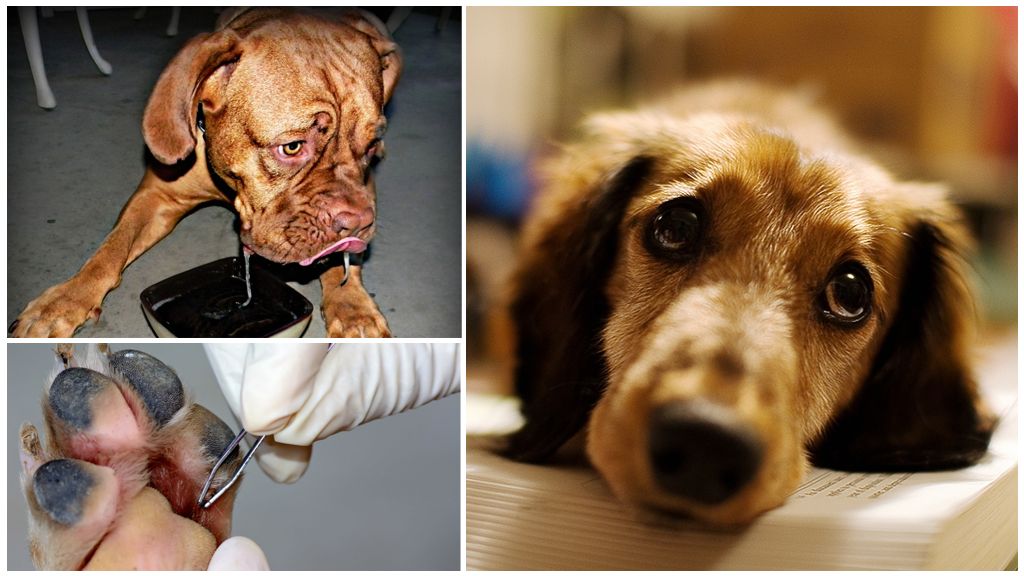- Squad of ticks Ixodidae
- Psoroptoid mites
- Choripoid mites
- Sarcoptoid tick and demodicosis
Each owner of walking animals faced the problem of attack ixodid ticks. These bloodsuckers attack any warm-blooded animal: agricultural, domestic, wild. But ticks in animals are not limited to ixodidae. The latter are only polyphages. In addition to them, there are specific arachnids that can inhabit only one of the animal species. But the consequences of infection with parasites are similar, as are the methods of their treatment.
Types of ticks in animals
Ticks in domestic animals differ in size, morphology and lifestyle. They can be temporary parasites (ixodic) or permanent, that is, spending their whole life on the host. Tick parasitic animals are divided into 2 groups: cutaneous and subcutaneous.
To skin include:
- ixodic;
- psoroptoids;
- choriptoids;
- otodectoids.
On a note!
Of the subcutaneous animals, only two genera parasitize: sarcoptoid and demodexoid.
Squad Ixodida
The individuals of this detachment are the largest of all ticks. The detachment has more than 900 species. All representatives of the order have a similar morphology, slightly differing from each other. They have egg-shaped bodies, 4 pairs of paws and brown tones. The squad of ixodid ticks includes 3 families:
- argazides (argus ticks);
- ixodides (best known as ixodids);
- nuttalliellids.
The last family is the poorly studied endemic of Africa. Reliable data on on whom it parasitizes is not yet available.
Argas Mites
Argazides parasitize on cats, livestock and poultry. Man is no exception. The size of argas ticks is from 3 to 30 mm. The body is oval, flattened. In a hungry individual, the color is yellow-brown or grayish. It is full brown. They differ from ixodids in the absence of a hard protective shell and paws “hidden” under the body. If ixodid resembles a spider, then argus resembles a crawling plaque.
Interesting!
Argazids can live without food for 11 years.
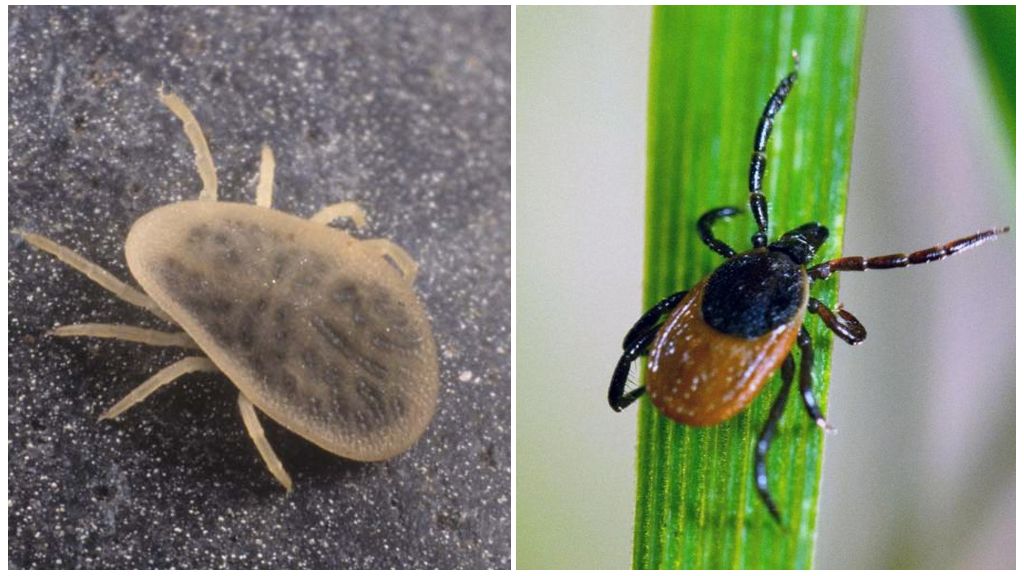
Ixodid ticks
Ixodides are the most famous and most annoying family. More than 700 species of ixodid ticks are distributed throughout the globe. Ticks of this family are found even in Antarctica and the Arctic, parasitizing on birds.
Most famous taiga and dog ticks. They have a three-level type of development: larva, nymph, adult. To go to a new stage of development, the tick must drink blood.
Morphologically, these two species are very similar:
- tick size 3-4 mm hungry female and 2.5 mm male; after drinking blood, an adult female swells up to 10 mm;
- ovoid body with a very sharp tip from the side of the head;
- dark brown protective shield in the male covers the whole body, in the female only the upper body;
- the color of the drunken blood of the female is light gray;
- arachnid appearance;
- 4 pairs of paws.
Dog tick is more common than taiga, and is able to parasitize on any warm-blooded organism. Females prefer to drink blood from cattle, but dogs also come back from a forest walk, hung with these ticks.
On a note!
Ixodides are temporary parasites. Drinking blood, they fall to the ground.
Psoroptoid mites
These are permanent cutaneous parasites. Their life cycle runs completely on the host.Until recently, it was believed that there are 4 species of psoroptoid ticks morphologically indistinguishable from each other, but parasitic each on its own host. Recent genetic studies have shown that it is one and the same species. That is, pets of different species can be infected by psoroptosis from each other. The tick parasitizes on:
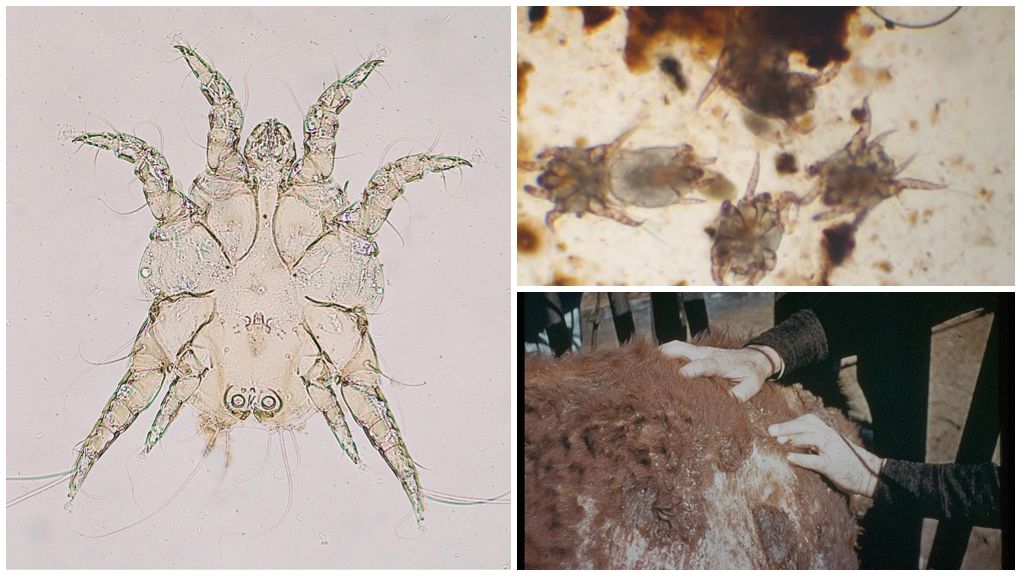
From the entire genus of psoroptoid ticks, only Psoroptes ovis, a sheep psoroptoid tick, was left. Psoroptoid - the largest of those that constantly parasitize on the skin of animals. The length and width of the body of the female is 0.8-0.4 mm, of the male is 0.5-0.2 mm. The body is oval. At the ends of well developed legs are suction cups. The oral apparatus is piercing-sucking. The full life cycle takes 14-25 days.
The livestock habitat is the neck, withers, back and sacrum. In rabbits, parasites settle in the ear area.
There is no photo of the tick on animals, you can see only the "consequences" of its life. This species feeds on blood and lymph. Saliva irritates the skin and causes scabies in animals. In the place of bites, wool falls out and exudate is secreted. Drying, the liquid forms greasy crusts. Combing the itchy places, the animal introduces a secondary infection into the wounds and causes purulent inflammations. This can be seen in the photo with psoroptosis.
Important!
The tick is very contagious and easily passes from one animal to another.
Choripoid mites
They cause another type of scabies in animals. Parasites are specific and this time really differ from each other even morphologically. Although the differences are very small: at the level of the length of the hairs. Horiptoid mites parasitize on such animals:
- horses;
- cows;
- Sheep
- goats;
- rabbits.
On a note!
The habitats of the parasites vary depending on the animal. In horses and cows, chorioptosis begins with the put joints of the hind legs. Because of this, it is called "foot scabies." In goats, parasites prefer areas with long hair. In rabbits, chorioptosis begins with the auricles.
The body of the chorioptotic tick is oval, transparent. The length is 0.3-0.4 mm. The mouth apparatus is gnawing. On the extremities of the sucker. The length of the legs of the fourth pair is 3 times less than the third. The average duration of the development cycle is 18-20 days, depending on environmental conditions.
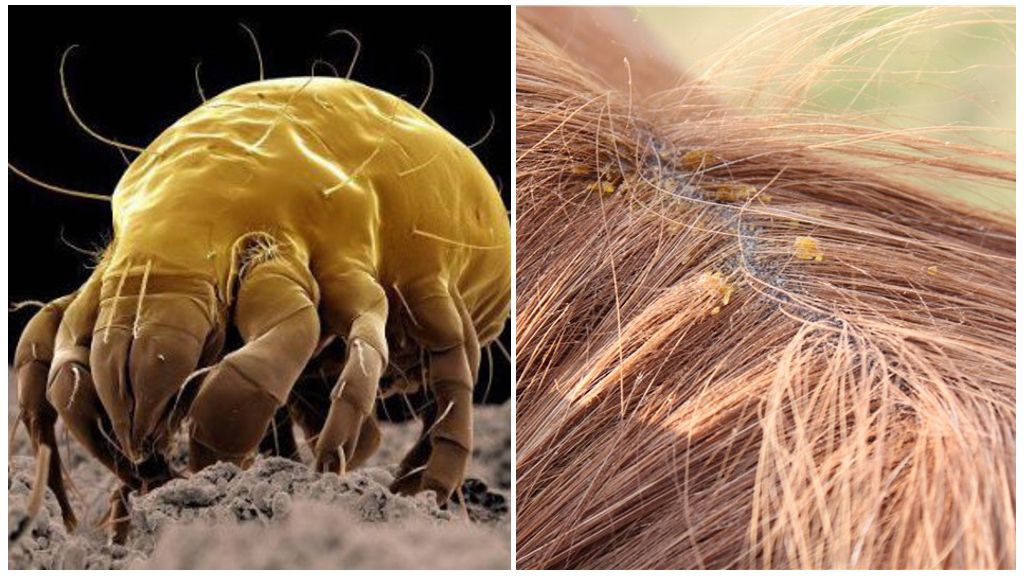
Otodectoid Mites
There is only one species in the genus of otodectoids - Otodectes cynotis. Parasitizes on carnivores:
Parasites are able to move from one species of animal to another. Particularly favorable conditions for infection with otodectosis exist on fur farms.
The causative agent of ear scabies has an almost oval-shaped transparent body and whitish color. The length of the parasite is 0.3-0.7 mm. The oral apparatus is piercing-sucking. It can reproduce only in the auditory canals. The duration of the development cycle depends on the ambient temperature: in the fall and winter of 18-22 days; in spring and summer 13-15 days. Without a host, this species of ticks can survive up to 25 days at a temperature of 3-7 ° C and up to 14 days at -5-0 ° C.
Sarcoptoid tick
There is only one species in the genus of sarcoptoids - Sarcoptes scabiei, aka scabies itch. Inhabits and multiplies in the thickness of the epidermis. It affects almost all types of mammals, including humans. The development cycle is the same as for cutaneous species. The duration of the cycle is 14-28 days. Without a host, itching does not last long: 10-14 days at a temperature of 11-20 ° C. The life span of animal animals is 45-60 days.
The body of scabies itching is almost round, 0.2-0.5 mm in diameter. Females are 2 times larger than males. The color of itch is white or yellowish white. The body is almost transparent.
On a note!
In animals, scabies begins with the skin of the head, neck, chest, limbs, and tail root.
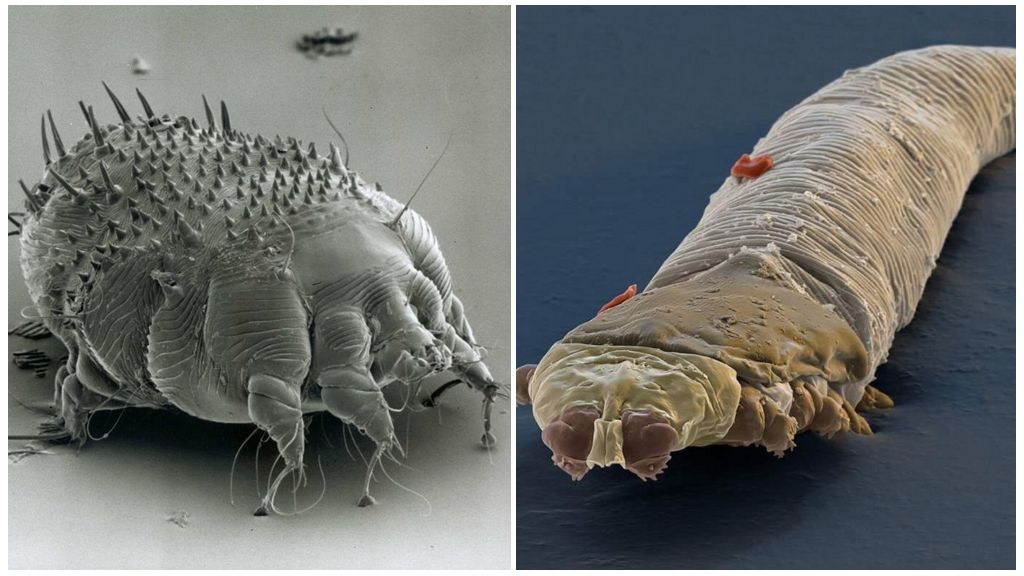
Demodectic ticks
Mites of the genus Demodex do not cause itching in animals when parasitized in hair follicles. These parasites have a cigar-shaped body shape, completely unlike other ticks. The length of the female is 0.3 mm, the male 0.2 mm. The maximum body width is 0.06 mm.
All demodexes morphologically similar, but each species parasitizes on its own animal. In human economic activity, the most important are those demodexes that parasitize pets:
- Demodex bovis - cattle;
- Demodex phyloides - pigs;
- Demodex ovis - sheep;
- Demodex caprae - goats;
- Demodex equi - horses;
- Demodex cati - cats;
- Demodex canis - dogs.
Infection occurs with close contact of a sick individual with a healthy one, so the first foci of damage are usually localized on the head, sides, neck. Very rare on the back.
Important! With extensive skin damage, demodexes migrate to the internal organs: the liver and spleen. Inside the body, ticks enter the resting stage.
